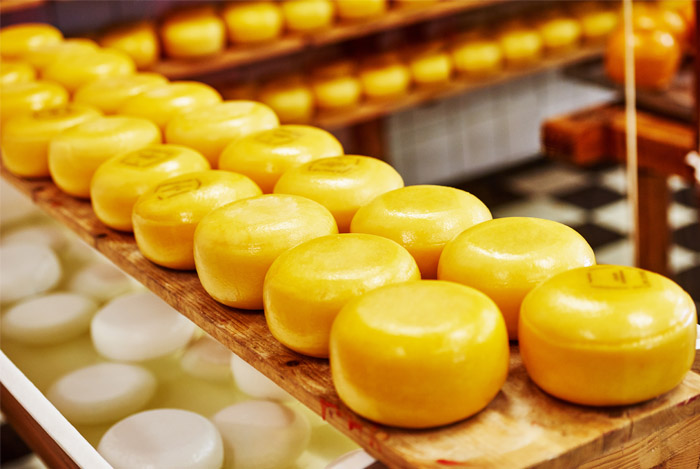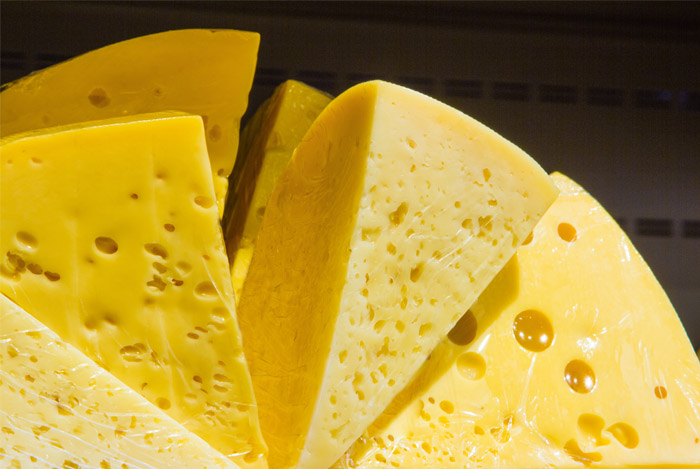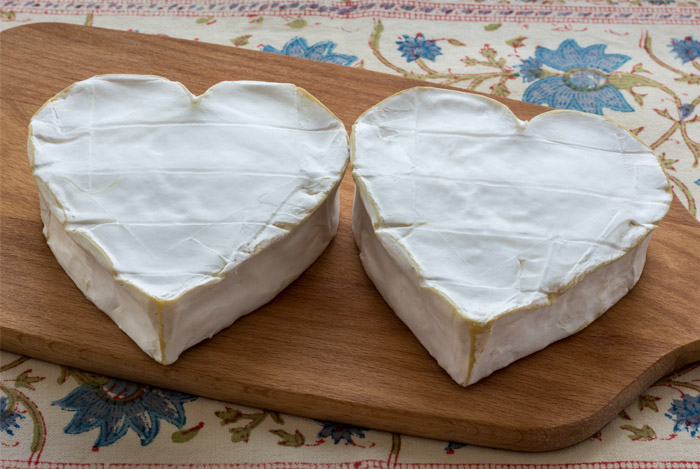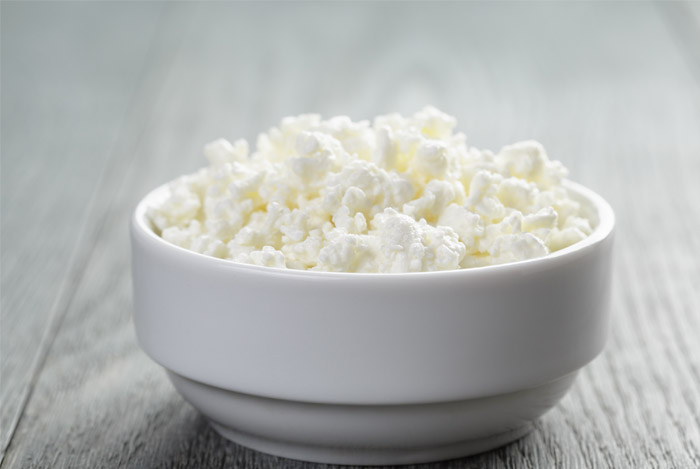If you’re a huge cheese fan but you aren’t sure whether or not you should include it in your diet, I have some good news for you: Cheese has some awesome health benefits.
When trying to maintain your health, I know at first glance cheese seems like it would fit nicely on any list of ‘foods to avoid’, but look again.
Cheese, especially the kind that comes from grass-fed cattle, is a fantastic source of some of the most important nutrients your body needs. And while it isn’t exactly a superfood, eating it regularly may provide you with benefits you might not find anywhere else.
Let’s learn more about cheese.
What is Cheese?
 Cheese can be produced in a number of ways – nearly as many ways as there are kinds of cheese to choose from. But, while some cheeses require extra steps and some occasionally difficult procedures to create properly, at its core, cheese-making is a simple process.
Cheese can be produced in a number of ways – nearly as many ways as there are kinds of cheese to choose from. But, while some cheeses require extra steps and some occasionally difficult procedures to create properly, at its core, cheese-making is a simple process.
In its most basic form, cheese is made by curdling milk, the same process that produces yogurt, wherein the milk coagulates and the stuff inside it can be separated.
The solid parts (fats and proteins) are split from the liquids (whey protein and water), and what happens afterward determines what kind of cheese you’ll end up with.
Curdling milk can be performed with acids like lemon juice or vinegar, or with an enzyme like rennet. Depending what acid is chosen, this alters the end product, changing the consistency, appearance, and flavor of the cheese.
Softer cheeses have not been aged as long, and have usually been made with acids. These include cheeses like cottage cheese, sour cream, Brie, Camembert, and ricotta.
Semi-hard to hard cheeses made with rennet and ripened by natural (or sometimes added) bacteria or mold, include Colby, cheddar, Swiss, Parmesan, Blue, Roquefort, and Asiago. Because of the way they’re served, these are often better known as grating cheeses.
The Awesome Nutrients in Cheese
 Because cheese is a dairy product, it contains a lot of the same nutrients you can find in milk or yogurt, but often in different amounts, depending on the variety of cheese you’ve chosen.
Because cheese is a dairy product, it contains a lot of the same nutrients you can find in milk or yogurt, but often in different amounts, depending on the variety of cheese you’ve chosen.
To receive the nutrients they contain, the United States Department of Agriculture recommends 2 to 3 servings of some form of dairy product every day.
One of the greatest finds in dairy products is their calcium content. A one ounce serving of Swiss, cheddar, or mozzarella cheese, will provide you with around 200 milligrams of calcium. That’s a fifth of your recommended dietary allowance (RDA) of calcium right there.
Cheese, like all other dairy products, is also packed with protein. While Greek yogurt takes the cake when it comes to the highest levels of protein in dairy (around a whopping 18 grams), you’ll still be supplied with around 8 grams of protein in a single serving of hard cheese.
The average man needs around 56 grams of protein a day, and the average woman around 46, so a healthy serving of cheese can provide you with plenty of protein in a small amount of food.
Contained in most cheese is a plentiful supply of vitamin B12, zinc, selenium, vitamin A, vitamin K2, phosphorous, sodium, and riboflavin.
Cheese also contains probiotics, “good” bacteria that can help regulate your gut flora. Maintaining a healthy intestinal environment is essential to good health, and can provide tons of benefits, ranging from digestive, to brain, to heart health.
When you take antibiotics, sometimes the balance of “good” to “bad” gut bacteria can be thrown off, so eating cheese as one of your best sources for the “good” guys can replenish your supply and rekindle the healthy environment of your gut, leading to better health overall.
Harder cheeses have a much lower lactose content than other forms of dairy, so people with mild lactose intolerance may find they can use cheese to reach their daily calcium, protein, vitamin D, and probiotic allowances.
While cheese can sometimes have a very high fat content, it can also be very low, depending on the type of cheese you’re considering. Cheese fat itself is highly complex, containing within it hundreds of different types of fatty acids.
While a lot of the fats within cheese are saturated fats, the science is still out as to whether saturated fats are really the enemy. There’s also a fair amount of monounsaturated fat in cheese.
Great For Your Bones (and Teeth!)
 A diet with the right amount of calcium ensures you’ll have strong, healthy bones. Doing so can prevent osteoporosis and other bone problems associated with aging.
A diet with the right amount of calcium ensures you’ll have strong, healthy bones. Doing so can prevent osteoporosis and other bone problems associated with aging.
Osteoporosis is a condition where the bones are made fragile via decreasing bone mass and deterioration of bone tissue, leading to eventual fracture. As we age, our bone mass begins weakening over time, making bone health more and more important.
A 2007 study found that osteoporosis caused a shocking 1.5 million fractures per year, including 300,000 hip breaks, with women sustaining 75 percent of all hip fractures.
Dairy products, because they provide both calcium and proteins, represent a perfect source of nutrients for bone health. But cheese is particularly perfect. Because of the B-complex vitamins in cheese, the calcium provided can be better absorbed and distributed throughout the body.
And as for your teeth, aside from the obvious benefits provided by the high levels of calcium, a new study from the Academy of General Dentistry (AGD) has found that cheese protects your teeth from acid erosion, caused by coffee, tea, wine, soda, etc.
When we consume foods or drinks like those mentioned, the natural pH levels of our mouths drop, damaging tooth enamel over time.
Normally, saliva does the trick to bring these pH levels back to their normal state, but cheese can aid in the process by raising pH faster and higher, with only a third of a serving.
A study performed in Finland even found that the probiotic known as Lactobacillus found in cheese helped lower the count of cavity-causing yeast in the mouth.
So, if you want to keep your skeleton healthy down to the pearly whites, consider eating more cheese.
For Athletes
 Not everyone needs the same nutritional benefits as athletes. This is why cheese is practically tailor-made for athletes.
Not everyone needs the same nutritional benefits as athletes. This is why cheese is practically tailor-made for athletes.
While most people in America aren’t exactly looking to gain weight or bulk up, athletes very regularly are.
Full fat cheese can often be pretty high in calories, making it optimal for weight gain with the added benefits of the high levels of protein and calcium for heavier and stronger bones and muscle mass.
Athletes naturally want a higher muscle-to-fat body composition, so the fat burning conjugated linoleic acid (CLA) found in cheese is perfect for athletes. Found in the highest amounts in sharp cheddar, CLA promotes fat loss by converting fat to energy and minimizing the size of fat cells.
CLA is an antioxidant – enhancing the immune system by preventing disease, and an anti-inflammatory – reducing muscle and joint soreness after exercise and performance.
If you’re looking for better performance and more effective workouts, cheese may be your best bet.
Heart Healthy Benefits
 The “French Paradox” is something I’ve discussed before in previous articles, and it’s still being debated in academic circles.
The “French Paradox” is something I’ve discussed before in previous articles, and it’s still being debated in academic circles.
So named for the seeming impossibility of French health in relation to their diets (often high in saturated fats and heavy carbohydrates), the French Paradox has yet to have a real answer.
When it comes to cheese, however, the facts are clear. According to the International Dairy Federation, the average Frenchman ate the most cheese per capita of any other country. That’s 25.9 kilograms of cheese on average in France compared to a paltry 15.4 kilograms in America.
Yet somehow, the French maintain a low rate of coronary heart disease death.
And while I mentioned earlier that the argument over whether saturated fats were really the worst thing for heart health was still ongoing, that may not be all there is to it.
Could cheese be good for the heart?
In April of 2015, PBS reported about a group of Danish scientists who took on the French Paradox through the lens of their dairy habits.
By following 15 men on three different diets, each with the same amount of calories but with different types of dairy (milk, cheese, and butter), they found a correlation between eating cheese and the excretion of a molecule called TMAO, which is linked to cardiovascular disease.
Gökhan Hotamisligil, chair of genetics and complex diseases at the Harvard School of Public Health, said that this study aligned with other works in the field that drew correlations between cheese consumption and protective effects against cardiovascular disease.
While this was only a small study, with more research needing to be done on the subject of cheese and heart health, the initial research suggests a positive relationship between eating cheese, and a healthier heart.
A Word of Caution
 Not every health expert is sold on the benefits of cheese. So, if you must have cheese (and I think you should on occasion), there are ways to stay careful.
Not every health expert is sold on the benefits of cheese. So, if you must have cheese (and I think you should on occasion), there are ways to stay careful.
Like I mentioned earlier, high fat cheeses contain lots of saturated fats as well as high calorie levels, so when choosing your cheese be careful to always look for the low fat option. Light cream cheese or cottage cheese provide a lot of the same nutritional benefits as other cheeses, with as low as 1 gram of fat.
Cheese is also fairly high in salt. A high sodium diet can lead to complications like high blood pressure, increased risk of heart disease and stroke, and diabetes.
A slice of cheddar cheese contains around 174 milligrams of sodium, which isn’t much compared to the daily 2,300 milligrams recommended by the Centers for Disease Control and Prevention (CDC), but it really adds up, especially considering everything else you eat over the course of your day.
A recent study looking at diets high in animal proteins, including cheese, found that eating a diet rich in meat and cheese during middle age can double the risk of death, and possibly quadruple the risk of death by cancer.
Again, a well-balanced diet is of the utmost importance to all stages of life.
If it’s the flavor of cheese you’re really after, go for the stronger stuff. This means you’ll be able to more easily use less cheese while getting equivalent flavor. Go for cheeses like Parmesan or Asiago where a little goes a long way.
Perhaps you could even look for unpasteurized raw-milk cheeses that are legally available in some states, providing they’ve been aged a minimum of 60 days. However, the Food and Drug Administration (FDA) is not a big fan of anything raw-milk, and doesn’t recommend these cheeses for pregnant women, children, or people with compromised immune systems.
Proponents of raw-milk cheese argue that the food is safer because of the smaller production scale, because they’re normally created by grass-fed cows, and they contain potentially beneficial pathogens that would have been totally killed off during the pasteurization process.
The Final Word on Cheese
 If you have the common sense to not drench all your food in melted cheese, eat nachos every day, or order too much cheese-on-cheese pizza, you’ll probably be able to avoid the negative health effects associated with cheese while benefiting from all the positives I’ve discussed here today.
If you have the common sense to not drench all your food in melted cheese, eat nachos every day, or order too much cheese-on-cheese pizza, you’ll probably be able to avoid the negative health effects associated with cheese while benefiting from all the positives I’ve discussed here today.
At the end of the day, cheese is one of those foods where the policy of moderation applies most strictly.
You really don’t want to overdo it when it comes to any form of dairy, cheese among them. But you can still fit it into your diet, adhering to serving sizes and balancing it with other healthful foods.
So enjoy the taste and reap the benefits of cheese, applying as much thought and care as you would for every other part of your diet.
What are your favorite kinds of cheese, and how often do you eat them?
The post 4 Awesome Health Benefits of Cheese appeared first on Nutrition Secrets.
http://www.nutritionsecrets.com/health-benefits-cheese/
No comments:
Post a Comment